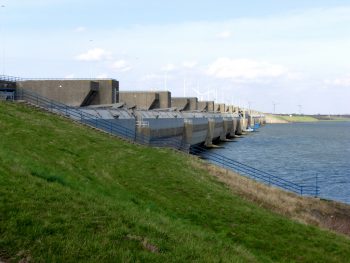The North Sea Dikes Open Once Again Posted by Karoly Molina on Jan 23, 2019 in Uncategorized
This month, the Haringvlietsluizen opened up to let fish swim between the North Sea and the Haringvliet which is south of Rotterdam in the province of South Holland. Parts of the dike will remain open so long as there is no risk of high water.
Haringvlietsluizen- History
The Haringvlietdam is part of the Delta Works which are the mix of sluizen (sluices), dammen (dams), and stormvloedkeringen (storm surge barriers) that protect about 700km or 435 mi of the coast of the North Sea.
Construction for the haringvlietsluizen began in 1956 and concluded in 1970. These are about 1 kilometer long (0.62 mi) with 17 spuiopeningen or opening gates. Above the sluizen, cars can drive connecting the delta Goeree-Overflakkee with the island of Voorne-Putten. Traditionally, the spuiopeningen are only opened based on the water the Maas and the Rijn rivers can take in. Controlling the amount of incoming water means the areas by the North Sea can stay afloat. You can read more about the dangers of flooding in this post about the Delta Works that I previously wrote or in the video below.
Life at the Haringvliet
While protecting the western provinces from flooding is certainly a priority (it is the most densely populated area of the country), the conservation of sea life and plants has recently received much needed attention. At the haringvliet, there has been an alteration in the balance between zoetwater or fresh water, zoutwater or salt water and the brak water or brackish water (a mix of the previous two). With the closing of the sluizen, the water in the haringvliet became fresh. The opening of the sluizen means that the water will slowly balance once again, typical plants of this area will regrow, and fish such as zalm (salmon) and zeeforel (sea trout) will return.
Concern from the Farmers
After the very warm summer we had in 2018 with extreme drought, farmers are concerned that “loosing” the fresh water from the haringvliet will mean there will be less fresh water for their land. When there is extreme drought, measures such as using the surplus fresh water in the haringvliet have been used. If this area is once again a mix of zoutwater, brak water, and zoetwater, will the farmers still get help? The Rijkswaterstaat has reassured the farmers that measures have and will be taken.
Will the sluices always be open?
The opening and closing of the sluices will be sporadic at first. There is a research team who is working to figure out how often the sluices can be open keeping in mind the safety of the area. The team will also look into how often the water needs to mix without causing severe damage. Ultimately, it will be a test and evaluate operation that will last a good while until “the right dose” is found.
The video below shows the moment of the official opening of the Haringvlietsluis. Do you have similar projects in your country? How is the need for safety and water balanced with nature?

Build vocabulary, practice pronunciation, and more with Transparent Language Online. Available anytime, anywhere, on any device.




